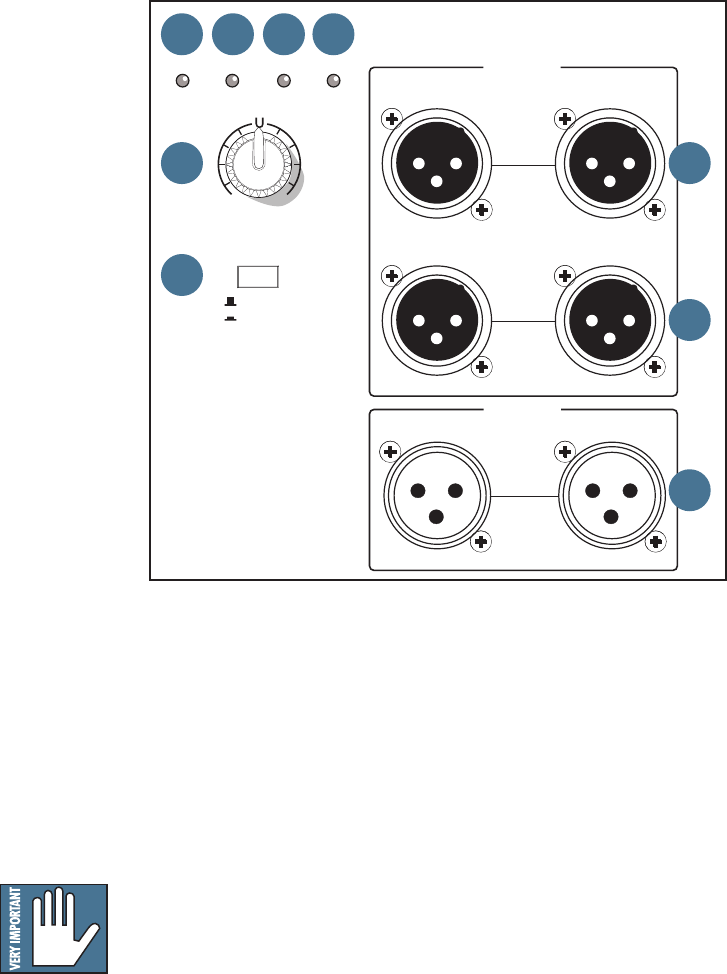
9
3. INPUTS
Balanced XLR female connectors are provided for the
left and right inputs. Connect the full-range line-level
signal from the mixer or other signal source to these
input jacks.
If you are connecting a single subwoofer output, or
LFE (low-frequency effects) output to the subwoofer,
you may use either the A or B input connector.
CAUTION: NEVER connect the output of
an amplifier directly to the input of the
subwoofer. This could damage the input
circuitry of the active subwoofer.
4. FULL RANGE OUTPUTS
Balanced XLR male connectors are provided for the
line-level A and B full-range outputs. Connect these
outputs to the inputs of another powered subwoofer,
main powered loudspeakers, or to an amplifier powering
passive loudspeakers.
The signal at these outputs is a direct copy of the
input signals. These outputs allow you to daisy-chain
multiple subwoofers, and/or send the full-range signals
to the main loudspeakers.
The level control and polarity switch have no effect
on the full-range outputs. The outputs are separate and
maintain the stereo separation of the input signals.
5. HIGH PASS OUTPUTS
Balanced XLR male connectors are provided for the
line-level A and B high-pass outputs. The subwoofer’s
internal active crossover splits the input signals into
two frequency bands. The low frequency range below
125 Hz goes to the internal amplifier that powers the
subwoofer. The frequency range above 125 Hz is sent to
these line-level output jacks.
Connect these outputs to the inputs of your main
powered loudspeakers, or to the inputs of the amplifier
powering the main loudspeakers. In this way, the main
loudspeakers will play the range above 125 Hz. If the
main loudspeakers have good low-frequency response,
then you may decide to use the full-range outputs [4]
instead.
The level control and polarity switch have no effect
on the high-pass outputs. The outputs are separate and
maintain the stereo separation of the input signals.
6. POLARITY
This switch reverses the polarity of the signal going
into the subwoofer amplifier by 180°. It has no effect on
the signal at the line-level outputs.
There is no right or wrong setting for this switch.
Listen to the overall blend of the subwoofer with the
rest of the system and select the switch position that
gives you the best sound for your audience. In fact,
your system may vary when positioned differently and
in alternate venues. Don’t be afraid to experiment with
the position of the polarity switch. See page 11 for more
information.
REVISION
SERIAL NUMBER
WARNING:
TO REDUCE THE RISK OF FIRE OR ELECTRIC
SHOCK, DO NOT EXPOSE THIS EQUIPMENT TO RAIN OR
MOISTURE. DO NOT REMOVE COVER. NO USER SERVICEABLE
PARTS INSIDE. REFER SERVICING TO QUALIFIED PERSONNEL.
AVIS:
RISQUE DE CHOC ELECTRIQUE — NE PAS OUVRIR
POWER
ON
BA
INPUTS
B
A
B
A
OUTPUTS
HIGH PASS
FULL RANGE
LEVEL
OL SIGNAL POWER
POLARITY
NORMAL
INVERT
THERMAL
+6dB 6dB
-
18-INCH POWERED SOUND REINFORCEMENT SUBWOOFER
118
7
6
5
4
3
9 10


















